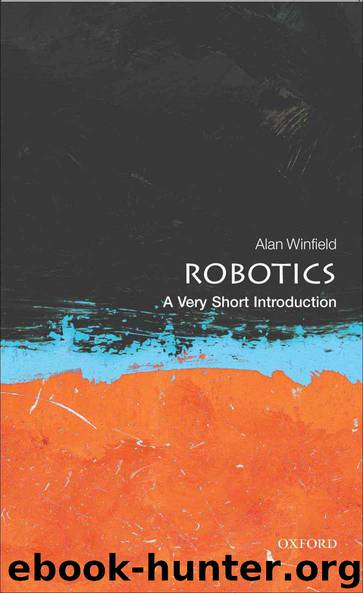Robotics: A Very Short Introduction (Very Short Introductions) by Alan Winfield

Author:Alan Winfield [Winfield, Alan]
Language: eng
Format: epub, mobi
Publisher: Oxford University Press, USA
Published: 2012-09-26T16:00:00+00:00
13. Jules, an expressive high-fidelity android robot head
Jules also has motors for gross head movements to nod or tilt the head, or simply provide small random movements (a robot head that is completely still would look unnatural). Of even greater importance are Jules’s eyes, which not only look human but are actuated to saccade in a lifelike way; furthermore, the eyes contain cameras, so that with appropriate face recognition and tracking software, linked to the eye motors, Jules can look at and track a human face. To complete the illusion, the robot’s eyelids are actuated to provide Jules with a periodic blink reflex.
An interesting and perhaps unique aspect of Hanson’s android robot heads is that the robot’s facemask can be modelled on a real person, and indeed one famous example is the Hanson robot model of science fiction author Philip K. Dick. With customized conversational software based on chatbot technology (which I discuss in Chapter 6), one could (somewhat weirdly) have a conversation with a robot that not only looks like a real person but appears to have the memories or personality traits of that person. Jules, however, is not modelled on a real person but was designed with statistically determined androgynous features.
There are clearly ethical questions raised by the fashioning of robots that behave as if they have feelings, since—whether the robot is a cartoon humanoid like Kismet or a high-fidelity and roid like Jules—the emotional states are entirely in the eye of the human beholder. None of these robots, nor any robot yet built, can truly be said to have feelings. They are at best robot actors, designed to deceive—and perhaps to shock if they descend into ‘the Uncanny Valley’ (see Box 2).
What if the robots are designed not for teenagers or adults fully cognizant of the artificiality of the robot and its emotions, but for children, naive, or vulnerable users who would have difficulty understanding that it’s a robot pretending to be happy, or sad, or pleased to see them? I believe this to be a genuine concern and something that requires ethical guidelines, as I discuss later in this chapter.
Box 2 The Uncanny Valley
Builders of humanoid robots face a unique and fascinating problem, known as the Uncanny Valley. Proposed by roboticist Masahiro Mori in 1970, the Uncanny Valley imagines how humans might react as robots become more human-like. His graph, shown here in Figure 14, has a horizontal axis that runs from 0 per cent human-like on the left to 100 per cent human-like on the right.
Mori argued that our reaction to robots will become more positive the more human-like the robot is, until the humanoid robot is very close in appearance and behaviour to real humans; but then, dramatically, we will have a strong adverse reaction to near-human-like robots. It is this reaction that Mori termed the Uncanny Valley. Mori also suggested that this adverse reaction will be more extreme when the robots are moving than when they are static. It is an idea that
Download
Robotics: A Very Short Introduction (Very Short Introductions) by Alan Winfield.mobi
This site does not store any files on its server. We only index and link to content provided by other sites. Please contact the content providers to delete copyright contents if any and email us, we'll remove relevant links or contents immediately.
Whiskies Galore by Ian Buxton(41835)
Introduction to Aircraft Design (Cambridge Aerospace Series) by John P. Fielding(33055)
Small Unmanned Fixed-wing Aircraft Design by Andrew J. Keane Andras Sobester James P. Scanlan & András Sóbester & James P. Scanlan(32739)
Craft Beer for the Homebrewer by Michael Agnew(18133)
Turbulence by E. J. Noyes(7929)
The Complete Stick Figure Physics Tutorials by Allen Sarah(7301)
Kaplan MCAT General Chemistry Review by Kaplan(6861)
The Thirst by Nesbo Jo(6819)
Bad Blood by John Carreyrou(6531)
Modelling of Convective Heat and Mass Transfer in Rotating Flows by Igor V. Shevchuk(6386)
Learning SQL by Alan Beaulieu(6202)
Weapons of Math Destruction by Cathy O'Neil(6128)
Man-made Catastrophes and Risk Information Concealment by Dmitry Chernov & Didier Sornette(5913)
Digital Minimalism by Cal Newport;(5653)
Life 3.0: Being Human in the Age of Artificial Intelligence by Tegmark Max(5460)
iGen by Jean M. Twenge(5361)
Secrets of Antigravity Propulsion: Tesla, UFOs, and Classified Aerospace Technology by Ph.D. Paul A. Laviolette(5305)
Design of Trajectory Optimization Approach for Space Maneuver Vehicle Skip Entry Problems by Runqi Chai & Al Savvaris & Antonios Tsourdos & Senchun Chai(5005)
Electronic Devices & Circuits by Jacob Millman & Christos C. Halkias(4896)
